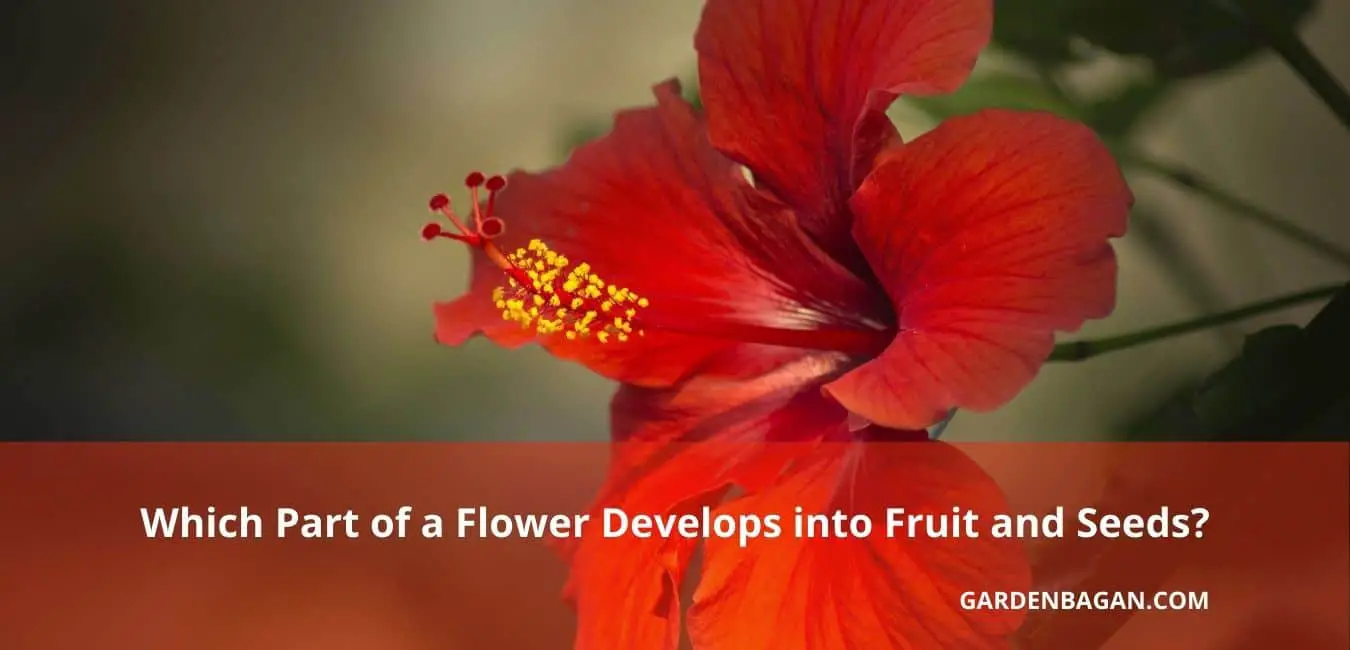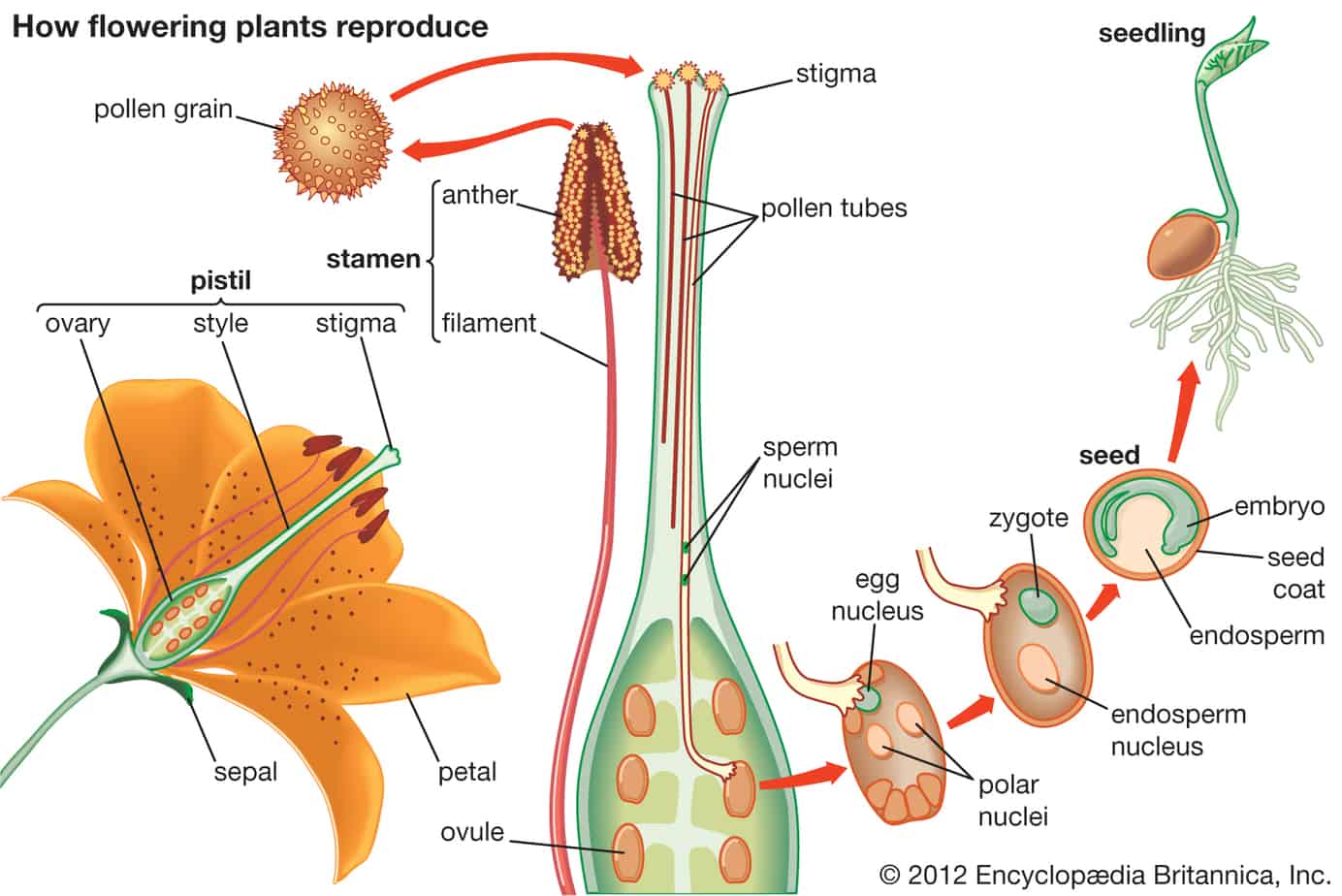Have you ever seen a flower develops into a fruit? Complete transformations occur in nature. Similar to the structure of flowers to bear the fruit. It is true, Not all flowers can bear fruits. Do you know- Which part of the Flower Develop into the Fruit and Seeds?- It is the Ovary and the ovules that simultaneously develop into fruit and seeds. The Ovary becomes the Fruit and ovules become seeds of the flower.

Check out my previous post: How to control Tomato Pests and Diseases?
Which Part of Flower Develop into Fruits?
A flower develops into a fruit after successful fertilization. When the pollen grain reaches the stigma from another flower. It starts developing long tubes to reach the ovary at the base of the flower.
The ovary is a small bulge at the base of a female flower. This ovary turns into a fruit after successful fertilization.
Sometimes you can see this ovary. It can be easily distinguishable between the stem and the flower base. The bulge portion indicates a cavity filled with tiny granules called ovules.
Also, read Are Plants Eukaryotic or Prokaryotic?
Which part of Flower develops into seeds?
The ovules present inside the ovary of the flower develop into the seeds. The enlarged basal portion of the pistil is the Ovary. It contains several tiny granular structures called ovules. Some of these ovules develop into seeds after successful fertilization.
The number of ovules presents inside an ovary can vary from plant to plant. Different species of plants have different numbers of mature ovules. Immature ovules are either aborted or fused with the ovary after fertilization.

Can we see seeds before fertilization?
Sometimes you can see seeds before fertilization of the flower. Although these are simply unfertilized ovules you can count on that.
Also, you cannot check ovules in every flower variety. Some species have very tiny ovary structures. So it is really difficult to open and see the tiny ovules inside such small ovaries.
You should look for the female flowers of the Cucurbitaceae or the Cucumber family. Also, hibiscus flowers are the best option for this experiment.
Start with a clean vertical slit mark on the ovary portion of the flower. Slowly try to open the pistil throughout the ovary.
You may see some fine grain-like structure embedded inside the ovary. These are the ovules that develop into seeds after successful fertilization.
Keep in mind there may be dozens of ovules present inside an ovary. But only a few of them will actually develop into seeds.
The rest of the undeveloped seeds will be aborted by natural selection. This phenomenon is not observable as the leftover seeds are consumed by the ovary itself. This is done to ensure the inheritance of the best healthy genes.
How does a flower develop in fruit and seeds?
Fruit and Seed development starts with the fertilization of the flower. A healthy flower has two distinct parts for reproduction.
The male part contains the anther and pollen grains. Whereas the female part contains Stigma, style, ovary, and ovules.
The anther is the male reproductive part of the flower that develops the pollen grain. This pollen grain contains the essential genetic information for the fertilization of the flower and further bio-mechanics.
The pollen grain travels to the stigma which is the female reproductive part of the flower. It is done by several pollinators like wind, water, insects, birds, or humans.
In favorable conditions, The pollen grain develops a tube-like root structure that grows through the style to the ovary.
Then the pollen releases two sperm nuclei to the ovary. These nuclei fuse with the egg cells inside the ovary and form the embryo and the zygote. Another sperm develops into the endosperm of the seed.
It forms the inner and outer structure of the seed inside the ovary of the flower.
In simple words, Fertilization occurs at this stage. the fusion of sperm nuclei in egg nuclei is the final step of fertilization of any flower.
This phenomenon happens with every ovule simultaneously. The Ovule form the structure of the seed. The zygote and endosperms collectively form the cotyledons and the embryo within the seed.
Check out this Can You Plant a Whole Strawberry?
Conclusion
Overall the fertilization of flowers results in the formation of fruits and seeds. The ovary at the base of the female reproductive part pistil forms the structure of the fruit.
It expands into a fleshy structure with a protective covering. The fruits provide protection and nourishment to the seeds.
The fertilized ovules become seeds. The covering becomes the seed coat.
The fertilized central core forms the endosperm and the egg becomes the zygote. The zygote forms the embryo that develops into the root, shoot and stem after germination.
The endosperm becomes the cotyledons to protect and nourish the embryo until it germinates and stabilizes.
Rose and hibiscus flowers are best to observe this phenomenon. Although finding a rel mature seed or fruit-like structure is a little difficult with these flowers.
The structure of the flower bears all the essential ingredients to form fruit and bears seeds for new life. It undergoes many changes to finally become a fruit.
What do you this about all these aspects of fruit formation? Share your thoughts and ideas. Keep reading keep gardening!
